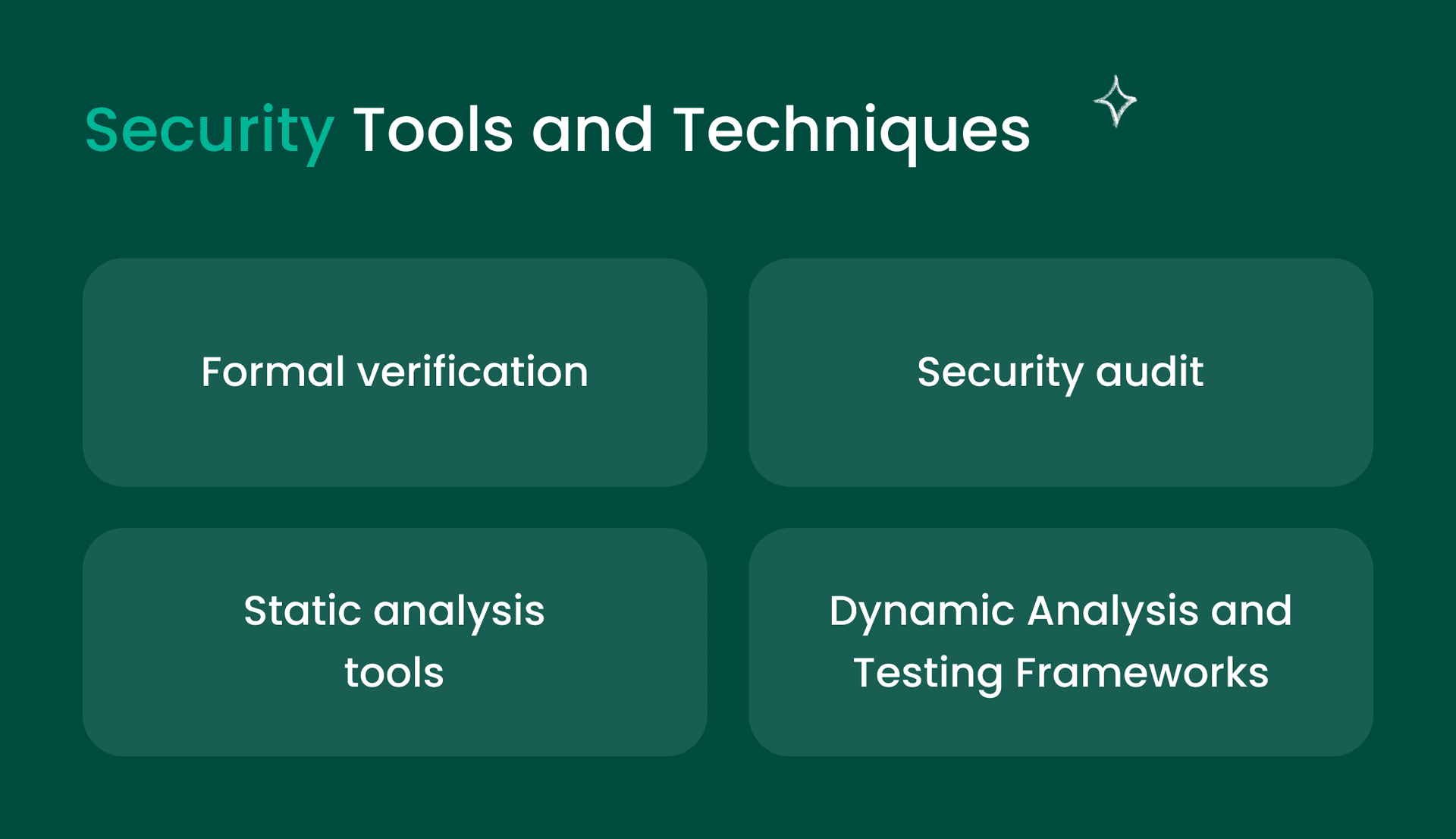The blockchain environment is constantly growing as new cases and applications appear unprecedentedly. The creation of smart contracts is becoming progressively more sophisticated in tandem with this quick expansion. Solidity-written smart contracts are the foundation for decentralized apps (dApps) on Ethereum and other blockchain systems, automating agreements and transactions without intermediaries. However, there is the risk of irrevocable money loss or data leakage if smart contract security is weak. Solidity programming language is still the most popular for developing smart contracts, so it is essential to comprehend and put security best practices into effect. Agilie's dev team draws on Solidity programming, risk reduction, and defense against possible threats in the blockchains to provide information about smart contract security design.
- Using tools including static analysis, formal verification, security audits, etc. assists professionals in smart contract development to identify and avoid known risks.
- This article covers the advanced tools and techniques that smart contract developers can use to guarantee security and optimize their blockchain-based solutions.
Understanding Smart Contract Vulnerabilities
Before we go further into smart contracting, we should identify the common vulnerabilities in developing these virtual structures. Smart contract creation can succeed or fail depending on the proper use of Solidity language. We have prepared an introduction list consisting of the most frequent security issues during smart contract development:
-
Re-entrancy attacks
-
Arithmetic overflows and underflows
-
Gas limit issues
-
Front-running
-
Dependence on timestamps
-
Short address/parameter attack
-
Code reuse
-
Delegate call injection
One of the main questions is how to prevent these vulnerabilities and develop safe smart contracts. Let’s continue with the exploration of this topic.

Best Practices in Solidity Programming
Utilizing the best industry practices in Solidity programming is an effective way to avoid common vulnerabilities and errors, increase efficiency, and ease of maintenance, ensuring that blockchain app is reliable. The following practices of top Solidity programmers aid in developing secure and highly efficient smart contracts.
Use Latest Solidity Compiler Version
Prepare smart contracts based on the newest detectable version of the Solidity compiler that has been considered by the developers and eliminated known vulnerabilities beforehand.
Limitations on contract size
The implementation will become invalid as the size of large contracts can go beyond the supported maximum size limit of the Ethereum virtual machine. The larger the codebase of a contract, the smarter it is when broken down into a few simple contracts that interact.
Data location
Grasping the difference between storing and keeping Solidity data in the memory is key. Storage is indefinite and hence expensive, while memory is ephemeral and low-priced. Blockchain developers can cut gas bills and enhance efficiency by providing proper contract storage.
Explicit visibility specifiers
Guarantee the visibility of a function and variable by explicitly stating them. Solidity has "public" functions by default meaning that anyone can call them. Such situations can expose the hidden functions at risk if the sensitive functions are illegally open. Select "private" or "internal" for functions and variables that should not be accessed outside the contract, and "external" for functions that will be called only externally.
Avoiding loops and recursions
Recursive calls and loops may unintentionally exhaust gas and exceed the block gas limit. Loops operate on variable-sized data structures or recursive calls, which can give way to unnecessary gas consumption or DoS attacks due to gas exhaustion. So, it is better to avoid them.
SafeMath for arithmetic operations
Use the SafeMath library for arithmetic operations to guard against overflows and underflows.
Deploy security patterns and audits
Deploy security patterns, validate, and do not neglect the re-entry locker system. Accordingly, accurate audits, including automatic analysis and manual code inspection, are of great need in finding and taking measures for possible weaknesses.
Event logging
Log key activities of the contract by using events. Events contribute to debugging and are like a screen that shows the whole process and all the steps, which increases responsibility and confidence in the process.
Integrating these leading practices into Solidity programming is a great start. Agilie, as a blockchain software development company, is well-versed in all the blockchain intricacies. Our team of developers with extensive experience is ready to create secure smart contracts and scalable blockchain applications to meet all client's needs and provide full technical support.
 Learn more about some of our successful cases.
Learn more about some of our successful cases.
We offer to discover what tools and techniques for smart contracts security Agilie’s team uses and recommends.
Tools and Techniques for Security
As blockchain network gets more intricate and valuable, the need for accurate tools and methods to protect against fraud also increases. Let's analyze a set of tools that developers can use to detect weaknesses, make application faster, and carry out testing.

Static analysis tools
Static analysis is the procedure of reading and examining the code without running it to find various vulnerabilities, coding errors, and deviations from best practices. The Ethereum development community extensively applies tools like Slither, Mythril, and Solhint to aid in this task.
-
Slither: Solidity's static analysis platform which, identifies vulnerabilities, for example, access to re-engines, untested low-level calls, arithmetic faults, and code improvement opportunities.
-
Mythril: the open-source security analysis tool for Ethereum smart contracts. It executes symbolically, finds contamination, and performs control-flow verifications to unveil various security vulnerabilities and ensure contracts comply with security best practices.
-
Solhint: This linter serves as a tool to provide style and security rules for Solidity code. It includes safety regulations and stylistic recommendations ensuring smart contracts are secure and simple to maintain.
The static analysis builds into the lifecycle of the developers. As a result, the early detection and elimination of security flaws occur.
Formal verification
Formal verification is a strict mathematical method that will either enforce or negate the correctness of smart contract algorithms that depict certain formal specifications or properties. This step is embodied in constructing a mathematical representation of a smart contract and using tools like the K Framework or Isabelle.
-
K Framework: Open source framework, which lets to declare, write, and formally confirm the system functionality.
-
Isabelle/HOL: An assistant for the higher logic that enables the performance of the formal proofs to verify the properties of the smart contracts. This fact is highly important for use in complicated contracts, where the highest precision and reliability are required.
Dynamic Analysis and Testing Frameworks
Dynamic analysis involves the smart contracts' running and checking in a controlled environment to dig out the vulnerabilities not discovered by static analysis. The most commonly used tools include Ganache and Echidna.
-
Ganache: aspect of the Truffle Suite, a personalized Ethereum development blockchain capable of deploying contracts, developing apps, and executing tests.
-
Echidna: a smart contract parser for Ethereum written in Haskell. Echidna applies the property-based testing technique to generate random inputs for contract functions and detect faults.
Security audit
A security audit needs a manual review of the contract code by security analysts to locate any possible vulnerabilities or logical errors that have not been identified by automated tools.
Agilie intends to improve the security of the smart contracts by adopting these advanced instruments and approaches in the development process, which includes 6 steps:
Step 1: Creating a smart contract concept.
Step 2: Choosing the platform.
Step 3: Tools selection.
Step 4: Development.
Step 5: Testing.
Step 6: Deployment.
This creates an environment where customers and partners experience object-oriented, efficient, and reliable blockchain solutions.
 Read more about the smart contract development process.
Read more about the smart contract development process.
Conclusion
The issue of smart contract security is one of great concern along with the fast development of blockchain technology. Developing a secure smart contract design is very important, which is a fundamental responsibility of users and customers who use digital agreements in many applications. Among many programming languages, Solidity is the most prominent for Ethereum smart contracts. It features some powerful elements but also comes with obstacles for the developers. Using newer versions of the compilers, knowing the smart contract secrets and vulnerabilities, implementing advanced security measures, and following the newest instructions are also vital, alongside the utilization of up-to-date tools and methods for security flaw detection.
Agilie always learns about the newest research results and tendencies in the blockchain field, to make its methods perfect for secure smart contracts. We welcome you to understand how our dev team can help you to accomplish your blockchain development needs. Together, we will create an innovative and secure world for the blockchain technology.
